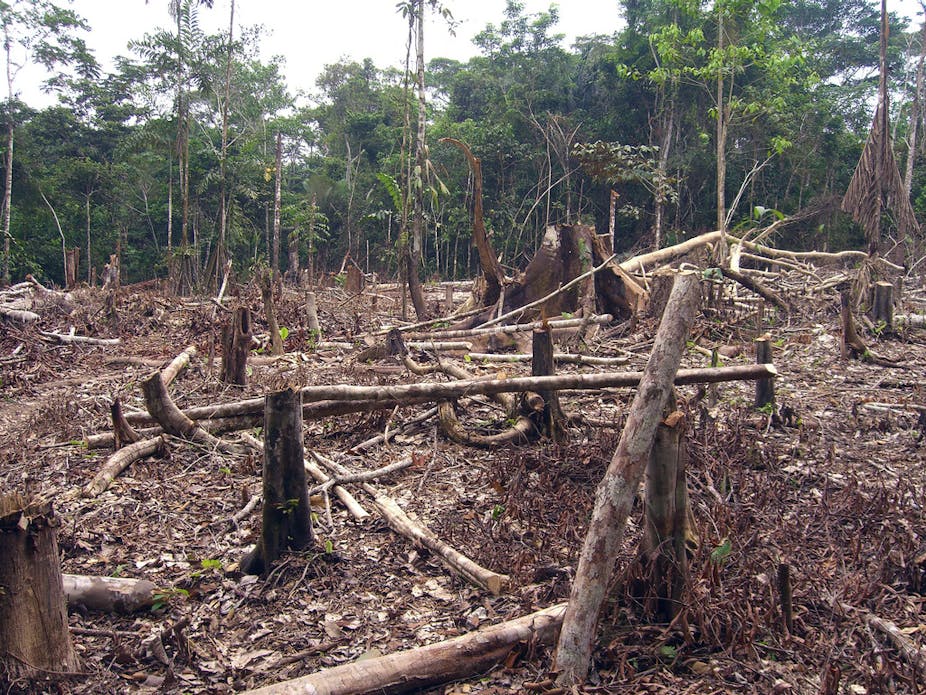With current concerns focusing, quite rightly, on controlling carbon emissions, it is easy to lose sight of the need for continued conservation efforts. In fact our recent study published in the Proceedings of the Royal Society B on the long-term recovery of rainforests should come as a warning; we found that deforested areas took much longer – more than a century – to recover their previous range of wildlife and plant biodiversity than they were to recover their ability to store carbon.
This lack of biodiversity indicates a significant extinction risk for tropical species, and may prevent full carbon recovery too. Today, degraded rainforests, those that have recovered after major disturbance, outnumber ancient, virgin forests. It is time we paid greater attention to these important habitats.
Why secondary forests matter
Virgin, or primary, forests are the A-list poster boys for tropical conservation, used to secure research funding in much the same way as the next hot young thing is used to sell a film. However much like the real A-list, primary forests are outnumbered by those considered less important. Degraded, or secondary, forests now make up about 60% of all forests because of the effects of land clearance, logging and other human activities.

Previous studies have conclusively shown that primary tropical forests deserve to be poster boys. They consistently have higher conservation value than forests damaged by humans, and store more carbon per hectare.
But degraded secondary forests are still important. Those forests regrowing from agricultural clearance can help soak up much of the carbon emissions we produce and may reduce the risk of extinction faced by some forest species.
However, not all secondary forests are equal. Of their many differences, the most important is age. And unlike in the superficial world of celebrity, older does equal better. With this in mind we decided to investigate the recovery rates of carbon and plant biodiversity in these secondary forests after agricultural use stopped.
Slow recovery
We collated data from more than 600 sites throughout the tropics, most of which came from Central and South America. Our study demonstrates that after about 80 years following the last disturbance, secondary forests still retained only about 85% of the carbon found in undisturbed forests.
More worrying is the limited biodiversity found in recovering forests. While the number of tree species increased rapidly, recovering after 50 years, the type of tree species in secondary forests is very different from primary forests. On average only about 25% of species found in primary forests were found in secondary forests. Our results also demonstrate that the number of epiphyte species -– plants that grow on trees -– had still not recovered after 100 years.
This should ring alarm bells for conservationists since these tree and plant species are those most vulnerable to extinction. They tend to have small populations, are restricted to a small number of locations and are sensitive to deforestation.
Though carbon stored in trees recovered reasonably quickly, it is likely that part of the reason secondary forests rarely reach the levels found in undisturbed forests is because of the lack of large, slow-growing tree species. These species, such as the giant kapok tree from South America, hold a disproportionately large amount of carbon and provide important habitats for epiphytes, so it may be well over a century before secondary forests can recover to the levels seen in undisturbed primary forests.
These slow-growing species probably aren’t found in secondary forests because their seeds rarely reach them. Secondary forests are often found in landscapes where clearing for farming has resulted in a patchwork of undisturbed forest, farmland and secondary forest. This farmland acts as a barrier to forest animals, such as birds, many of which will not fly across unforested land. Fruit and seed-eating birds help disperse tropical tree species’ seeds – if they cannot reach secondary forests to eat their seeds and fruit then certain tree species lose an important mechanism for replenishing their numbers.
Bolstering biodiversity
We think that one way to improve the biodiversity of secondary forests may be to help disperse seeds across these fragmented landscapes. The best way to do this may be to plant small islands of trees throughout the wider farmland area that can act as stepping stones to encourage the movement of animals and seeds between different patches of forest. This, along with planting of seedlings into secondary forest patches, may help plant biodiversity to recover.

It is vitally important that we recognise the benefits of conserving secondary forests and other degraded forests –- these are far from worthless ecosystems. At the moment many are cleared for farmland or plantations after only a few years re-growth, so the potential benefits for conservation and carbon storage they could offer are rarely achieved. To tackle tropical species extinctions it is vital to reduce the level of forest clearance, and encourage more sustainable use of tropical forest landscapes.

